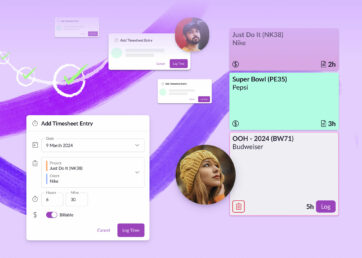Your project outcome is only going to be as good as the team behind it. There are no two ways about it—your project’s success depends on the skills, expertise, and experience of the project team you assemble.
That starts with an understanding of project team roles and responsibilities.
And that’s exactly what we’re here to do today.
In this article 📖
What is a project team?
A project team is a group of individuals brought together to work on a specific project or initiative. The team will include roles needed for project planning, development, and implementation.
The team members collaborate to achieve a set of predetermined goals as stated in the project scope. This could be the launch of a product or service, or delivering a new design or feature for a client.
Each member of the team has a unique set of skills and responsibilities that contribute to the success of the project—ultimately, completing the project on schedule and on budget.
Establishing a project team helps you ensure important projects have a dedicated group made up of various skills and experiences so the work can be completed as efficiently as possible.
Team roles can be assigned to full-time or part-time employees, contractors, subject matter experts, or other external stakeholders.
Roles and responsibilities definition
Roles and responsibilities are related concepts. This article will cover the roles of a project team (what specific positions and functions make up a project team), as well as the responsibilities (the duties and tasks tied to each specific role).
5 key project team roles and responsibilities
Every project has different requirements, so team structure can vary. But the five major roles in a project team are project sponsor, project manager, business analyst, resource manager, and project team member.
Let’s dive into the roles and responsibilities of each, and how they work together.
1. Project sponsor: The person driving the vision
The sponsor is the in-house champion of a project, overseeing operations from a high level. This person works directly with the project manager, clearing any obstacles that threaten to stall the project and signing off on all major components.
A member of senior management typically fills this role. A project sponsor’s responsibilities include the following:
- Creating the project vision
- Earning buy-in from executive leadership
- Making critical decisions
- Approving the project budget
2. Project manager (or leader): The person managing day-to-day operations
Project managers or leaders are responsible for day-to-day operations and ensuring the project is completed on time, on budget, and achieves its objectives.
On a small project, the manager might oversee each team member. On a larger-scale project, they are more likely to oversee team leaders, who each manage their own group.
The project manager is responsible for the following:
- Creating the project plan and schedule
- Recruiting project staff
- Managing the budget
- Managing the project schedule
- Delegating project tasks to team members
- Managing all project deliverables
- Communicating with upper management and other stakeholders
3. Resource manager: In charge of resource allocation and utilization
The resource manager is critical when putting together your project team. Now, if your project isn’t big enough to require a resource manager, you’ll simply have to act as one. So what does that mean exactly?
- Identify the right people for a project
- Match project team roles and skills with project needs
- Allocate and schedule the right resource within the project timeline and budget
- Stay on top of resource availability and utilization
- Monitor and optimize the use of resources throughout the course of the project to make sure it can be completed successfully
4. Business analyst: Makes sure you have the data you need
The business analyst is responsible for gathering and analyzing data related to the project. They help identify the project’s requirements and determine the best approach to achieve the project’s objectives. They work with stakeholders to ensure that the project’s deliverables meet the organization’s needs.
The business analyst ensures the project team has the technology and tools to do their jobs effectively. They might also recommend new tools for streamlining workflows and improving quality, such as resource scheduling software.
A business analyst:
- Helps define the project and its goals
- Gathers technical requirements from team members
- Documents and analyzes project requirements
- Helps project team solve equipment management problems
- Tests solutions to ensure their effectiveness
5. Project team member (or project delivery team): Individual contributors assigned to different project tasks
Project delivery team responsibilities vary between projects and roles (which may include anything from developers and engineers, to designers and copywriters).
At a high level, all project team members are assigned the tasks required to complete the project, and are responsible for:
- Contributing to the project goals and objectives
- Completing individual tasks within the expected time frame
- Collaborating with other team members
- Communicating with the project manager about roadblocks
Other roles in a project team
Some larger projects require additional project management roles and responsibilities to support the core project team. These may include:
- An executive sponsor is a senior owner of the project (with more authority than the project sponsor) and the ultimate decision-maker
- A project owner is usually the person who proposed the project. They assist the project manager in ensuring successful implementation
- A project lead is someone who carries out a lot of the tasks of the project manager but doesn’t have as much experience or official qualifications
- A team leader is responsible for training team members and monitoring progress toward project objectives
- A functional manager’s responsibility can vary, but the primary function is to ensure the project team has the resources it needs, and address problems that slow down the project
- A program manager coordinates all projects related to a specific program and provides guidance to the project manager
- A subject matter expert (SME) has advanced knowledge of a specific area, practice, or process. They provide guidance and strategy to the project team
- A project coordinator or project management office (PMO) offers administrative support to the project team and establishes standards to ensure the team’s processes align with broader organizational goals
- Project stakeholders are people (internal or external to the project) who have an interest in and influence over the project. Their responsibilities and interests vary between (and even within) projects
- A steering committee includes senior-level stakeholders (such as the project sponsor) and company managers, and provides strategic support to help define business needs and achieve project outcomes
Project team roles and responsibilities example
Roles in a team project can get confusing (fast). So to demonstrate how project team roles work together, let’s use the example of an in-house marketing team undertaking a website redesign.
Project sponsor: This is the person who “owns” the project. In this case, the Chief Marketing Officer (CMO) might decide the website needed an overhaul as part of a big rebranding initiative. For this project, the responsibilities of the project sponsor could look something like the following:
- Ensures the redesign aligns with strategic business goals
- Assigns with the project manager
- Provides resources and support for the redesign
- Serves as an escalation point when problems arise
Project manager: This person oversees the execution of the project and manages the team. In this case, let’s say it’s the creative director. The project manager:
- Communicates with the sponsor and project team
- Sets milestones and deadlines
- Ensures the redesign stays on schedule and on budget
- Monitors the progress of the project
Resource manager: As the name implies, this person ensures the team has everything it needs to complete the redesign. In this case, let’s say it’s the chief information officer.
- Identifies the best project team roles based on the project scope
- Plans and allocates people and resources (meeting rooms, equipment, etc.)
- Monitors utilization throughout the project and tracks billable hours
Project team members: These are the folks responsible for executing the redesign. They report to the project manager. The following roles need to be assigned:
- Front-end and back-end engineers
- QA engineer
- UX/UI designer
- Visual designer
- SEO expert
- Copywriter
Project team role and responsibilities matrix
Because roles and responsibilities can vary between projects, it can be helpful to create a RACI project team matrix at the very beginning of the project to clarify the expectations of each position.
RACI stands for responsible, accountable, consulted, and informed. It helps define the roles within a project management team and then identifies who needs to be looped in or assigned to each task.
It’s simple really, if everyone knows their roles within a project team, your project is much more likely to run smoothly.
The project team roles and responsibilities table below shows an example RACI matrix for project sponsors, project managers, resource managers, and project team members, but can be expanded to include more roles and tasks.

Now that we know more about what project team roles to include in a project along with their different responsibilities, find out how you actually go about building your project team here.
Project team roles FAQs
How do you decide what roles are needed on a project team?
To define the team roles needed for your project, outline the goals and key deliverables of the project. Think about the skills you need to ensure those deliverables are high quality, and then match and assign team members accordingly.
What are the benefits of defining project team roles?
The benefits of clearly defined roles include:
- Increase individual accountability
- Reduce confusion and overlap
- Give team members a feeling of ownership and clarity around expectations
- Enable project managers to delegate tasks and assess team members’ performance
- Establish a structure for effective problem-solving and collaboration
Can required project roles vary from project to project?
They absolutely can, depending on the nature of the project, the team structure, and the availability of specific skills and expertise. What matters is that the responsibilities for each role are clearly defined before work begins on the project.
What are the best practices when putting together a project team?
You’ll want to:
- Create a project scope
- Develop and follow a clear project plan
- Identify the project team roles needed for your project, and schedule your resources
- Establish some core project team values
- Encourage a collaborative project team culture
What are the roles in a project team?
To summarize, the roles on a project team can include:
- Project sponsor
- Executive sponsor
- Project owner
- Project manager
- Project lead
- Team leader
- Project team member or project delivery team
- Resource manager
- Business analyst
- Functional manager
- Program manager
- Subject matter expert (SME)
- Project coordinator or project management office (PMO)
Clearly defined project team roles mean a greater chance of project success
With the right project team, you’ve instantly increased the chances of project success (because let’s not forget—70% of projects fail). So you’ll want to invest in getting the right people on board from the get-go.
While it’s tempting to grab whoever’s available to get started faster and track against timelines, the wiser thing to do is to wait, assess, and carefully put together your team. As we said earlier—your project will be better for it.
Find the right people—faster—with Resource Guru
Whether you’re working with a big or small project team, resource management software can help find and allocate the right resources, monitor utilization, and create more accurate resource forecasting.
Try Resource Guru for free for 30 days. (No credit card required. No strings attached.)





